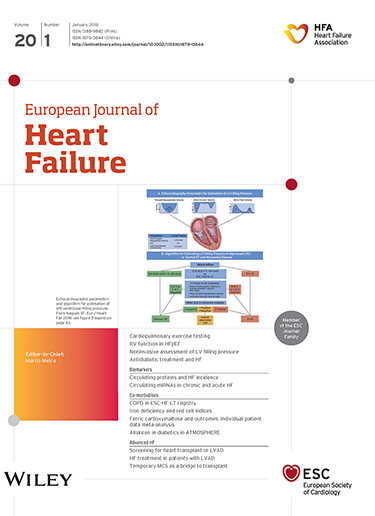Effect of glucagon-like peptide-1 receptor agonists on heart failure outcomes and cardiovascular death across varying cardiovascular-kidney-metabolic comorbidity.
IF 10.8
1区 医学
Q1 CARDIAC & CARDIOVASCULAR SYSTEMS
引用次数: 0
Abstract
AIMS Effects of glucagon-like peptide-1 receptor agonists (GLP-1RAs) on heart failure hospitalization (HFH) and cardiovascular (CV) death among patients with varying overlap of cardiovascular-kidney-metabolic (CKM) comorbidity are not well characterized. This study aimed to assess effects GLP-1RAs on HFH and CV death across populations with varying type and number of CKM comorbidity. METHODS AND RESULTS Online databases were queried through November 2024 for primary and secondary analyses of clinical outcome trials of GLP-1RAs in patients with heart failure (HF), type 2 diabetes mellitus (T2DM), chronic kidney disease (CKD), obesity, and combinations of these diseases. Primary outcome was a composite HFH or CV death. Secondary outcomes were first HFH and CV death. Hazard ratios (HRs), risk ratios (RRs), and their 95% confidence intervals (CI) were derived using random-effects models. Fifteen trials (n = 87 549) were included. Compared with placebo, GLP-1RAs reduced the relative risk of composite HFH/CV death in HF (HR 0.81, 95% CI 0.69-0.96), T2DM (HR 0.85, 95% CI 0.78-0.93), and obesity (HR 0.70, 95% CI 0.58-0.86), with a non-significant risk reduction in CKD (HR 0.79, 95% CI 0.61-1.01). GLP-1RAs reduced the risk of HFH in T2DM (HR 0.89, 95% CI 0.80-0.99) and obesity (HR 0.63, 95% CI 0.45-0.87), with a non-significant risk reduction among patients with HF (HR 0.85, 95% CI 0.69-1.04) and CKD (HR 0.82, 95% CI 0.64-1.06). GLP-1RAs also significantly reduced CV death in HF (HR 0.88, 95% CI 0.77-0.99), T2DM (HR 0.85, 95% CI 0.78-0.93), and in obesity (HR 0.83, 95% CI 0.73-0.93), with a non-significant risk reduction in CKD (HR 0.80, 95% CI 0.60-1.08). Effects were consistent across subgroups, except for HF with reduced ejection fraction (HFrEF), where GLP-1RAs showed a non-significant risk increase in HFH (HR 1.17, 95% CI 0.93-1.47) but significantly reduced CV death (HR 0.67, 95% CI 0.50-0.90). GLP-1RAs were not associated with increased risk for serious adverse events (RR 0.94, 95% CI 0.89-1.00). CONCLUSIONS Glucagon-like peptide-1 receptor agonists reduce HFH and CV death across CKM conditions, with generally consistent effects in varying combinations of these diseases. The potential exception is among patients with HFrEF, where a reduction in risk of CV death, but a numeric increase in HFH, was observed. Definitive CV outcome trials are needed to definitively determine effects of GLP-1RAs in patients with established HFrEF.胰高血糖素样肽-1受体激动剂对不同心血管-肾-代谢合并症患者心力衰竭结局和心血管死亡的影响
胰高血糖素样肽-1受体激动剂(GLP-1RAs)对不同重叠心血管-肾-代谢(CKM)合并症患者心力衰竭住院(HFH)和心血管(CV)死亡的影响尚不清楚。本研究旨在评估GLP-1RAs在不同类型和数量CKM合并症人群中对HFH和CV死亡的影响。方法和结果通过在线数据库查询到2024年11月,对GLP-1RAs在心力衰竭(HF)、2型糖尿病(T2DM)、慢性肾脏疾病(CKD)、肥胖和这些疾病合并患者的临床结局试验进行主要和次要分析。主要终点为HFH或CV复合死亡。次要结局为首次HFH和CV死亡。使用随机效应模型推导出风险比(hr)、风险比(rr)及其95%置信区间(CI)。纳入15项试验(n = 87 549)。与安慰剂相比,GLP-1RAs降低了HF (HR 0.81, 95% CI 0.69-0.96)、T2DM (HR 0.85, 95% CI 0.78-0.93)和肥胖(HR 0.70, 95% CI 0.58-0.86)中HFH/CV复合死亡的相对风险,而CKD (HR 0.79, 95% CI 0.61-1.01)的风险降低不显著(HR 0.79, 95% CI 0.61-1.01)。GLP-1RAs降低了T2DM (HR 0.89, 95% CI 0.80-0.99)和肥胖(HR 0.63, 95% CI 0.45-0.87)患者HFH的风险,而HF (HR 0.85, 95% CI 0.69-1.04)和CKD (HR 0.82, 95% CI 0.64-1.06)患者的风险降低不显著。GLP-1RAs还显著降低HF (HR 0.88, 95% CI 0.77-0.99)、T2DM (HR 0.85, 95% CI 0.78-0.93)和肥胖(HR 0.83, 95% CI 0.73-0.93)的CV死亡,而CKD (HR 0.80, 95% CI 0.60-1.08)的CV死亡风险无显著降低(HR 0.80, 95% CI 0.60-1.08)。除伴有射血分数降低的HF (HFrEF)外,其他亚组的效果一致,其中GLP-1RAs显示HFH的风险无显著增加(HR 1.17, 95% CI 0.93-1.47),但显著降低CV死亡(HR 0.67, 95% CI 0.50-0.90)。GLP-1RAs与严重不良事件风险增加无关(RR 0.94, 95% CI 0.89-1.00)。结论胰高血糖素样肽-1受体激动剂可降低慢性肾病患者HFH和CV的死亡率,在这些疾病的不同组合中具有普遍一致的效果。潜在的例外是HFrEF患者,他们观察到CV死亡风险降低,但HFH的数量增加。需要明确的CV结局试验来明确确定GLP-1RAs对HFrEF患者的影响。
本文章由计算机程序翻译,如有差异,请以英文原文为准。
求助全文
约1分钟内获得全文
求助全文
来源期刊

European Journal of Heart Failure
医学-心血管系统
CiteScore
27.30
自引率
11.50%
发文量
365
审稿时长
1 months
期刊介绍:
European Journal of Heart Failure is an international journal dedicated to advancing knowledge in the field of heart failure management. The journal publishes reviews and editorials aimed at improving understanding, prevention, investigation, and treatment of heart failure. It covers various disciplines such as molecular and cellular biology, pathology, physiology, electrophysiology, pharmacology, clinical sciences, social sciences, and population sciences. The journal welcomes submissions of manuscripts on basic, clinical, and population sciences, as well as original contributions on nursing, care of the elderly, primary care, health economics, and other related specialist fields. It is published monthly and has a readership that includes cardiologists, emergency room physicians, intensivists, internists, general physicians, cardiac nurses, diabetologists, epidemiologists, basic scientists focusing on cardiovascular research, and those working in rehabilitation. The journal is abstracted and indexed in various databases such as Academic Search, Embase, MEDLINE/PubMed, and Science Citation Index.
 求助内容:
求助内容: 应助结果提醒方式:
应助结果提醒方式:


